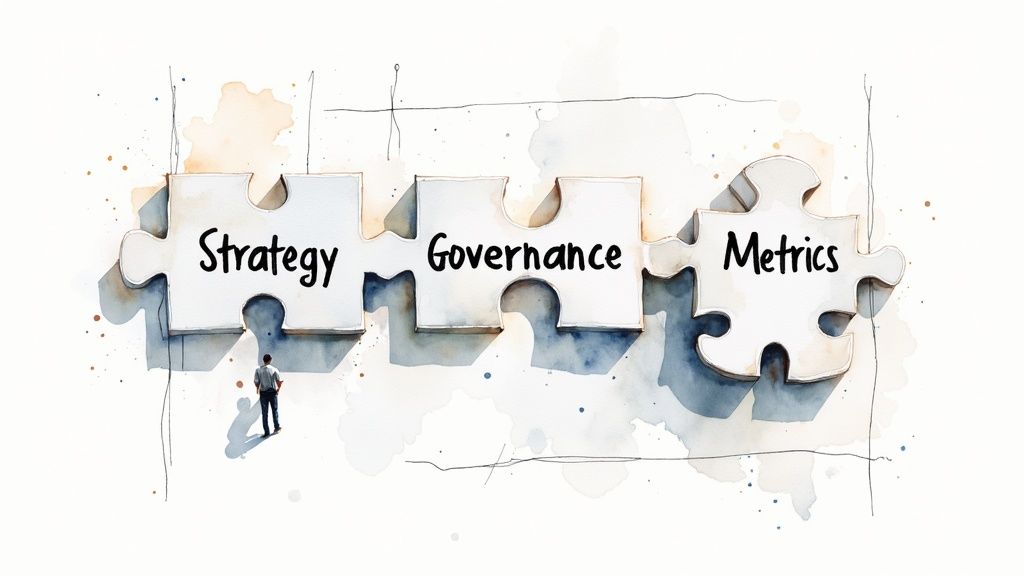10 Best Practices for Knowledge Management in 2025

In a business environment flooded with data, the ability to effectively capture, share, and leverage collective intelligence is no longer just a competitive edge-it's a core operational necessity. Many organizations find themselves drowning in information but starving for actionable wisdom. This is precisely where a structured approach to knowledge management transforms chaos into clarity, turning scattered data points into the strategic insights that fuel innovation, efficiency, and sustainable growth. Without it, valuable expertise walks out the door, teams reinvent the wheel, and critical decisions are made in the dark.
This article moves beyond generic advice to provide a comprehensive roundup of the 10 most critical best practices for knowledge management. Each point is designed as a practical, actionable step you can take to build a resilient, learning-focused organization. We will explore everything from creating a foundational strategy and fostering a vibrant knowledge-sharing culture to implementing the right technology and measuring the tangible impact of your efforts. By following this guide, you will gain a clear blueprint to turn your organization's collective knowledge into its most powerful strategic asset. Let's dive into the practices that will define success in 2025 and beyond.
1. Create a Knowledge Management Strategy and Framework
Effective knowledge management doesn't happen by accident; it requires a deliberate and structured approach. Creating a comprehensive knowledge management strategy is one of the most critical best practices because it provides a roadmap for your entire program. This foundational document aligns your knowledge initiatives with core business objectives, ensuring that every effort is purposeful, measurable, and integrated into daily operations. Without a strategy, knowledge-sharing activities often become fragmented, inconsistent, and fail to deliver tangible value.
A well-defined framework outlines the governance, processes, and technologies needed to manage your organization's intellectual assets. It answers key questions: What knowledge is most critical to our success? How will we capture, organize, and share it? Who is responsible for maintaining its quality and relevance?

Why This Approach Works
A formal strategy transforms knowledge management from a passive, ad-hoc activity into a proactive business function. For instance, NASA's Knowledge Management Framework is designed to capture and disseminate lessons learned from decades of complex missions, directly contributing to future mission success and safety. Similarly, consulting giant Accenture built its Knowledge Exchange framework to integrate directly into project delivery, ensuring consultants can access collective expertise to solve client problems faster.
This approach provides direction, secures executive buy-in, and clarifies roles, which is essential for long-term sustainability and impact.
How to Implement This Strategy
- Secure Executive Sponsorship: Gain support from leadership from the very beginning. Their backing provides the authority and resources needed for success.
- Define Clear Objectives: Connect your KM goals to specific business outcomes, such as reducing employee onboarding time by 25% or increasing proposal win rates by 10%.
- Involve Key Stakeholders: Collaborate with representatives from various departments to ensure the strategy addresses diverse needs and is practical to implement across the organization.
- Start with a Pilot Program: Test your framework within a single department or project. This allows you to identify challenges, refine processes, and demonstrate value before a full-scale rollout.
- Establish Success Metrics: Define how you will measure success. Key Performance Indicators (KPIs) could include content usage rates, search success rates, or time saved finding information.
2. Foster a Knowledge-Sharing Culture
Technology and processes are essential, but the most sophisticated knowledge management system will fail without a culture that actively encourages sharing. Fostering a knowledge-sharing culture is one of the most vital best practices for knowledge management because it addresses the human element. It involves shifting the organizational mindset from "knowledge is power" to "sharing knowledge is power," creating an environment of psychological safety where collaboration is the default behavior.
This cultural transformation is about making knowledge exchange a natural part of daily work, not an extra task. It tackles the behavioral barriers, like knowledge hoarding and fear of criticism, that often prevent even the best systems from being effective. When people feel valued and safe, they are more willing to contribute their expertise and learn from others.

Why This Approach Works
A supportive culture makes knowledge management sustainable. For example, Pixar's "Braintrust" meetings create a safe space for candid feedback, ensuring creative knowledge is shared to improve films. Similarly, Microsoft's shift under Satya Nadella to a "learn-it-all" culture transformed the company, promoting cross-departmental collaboration and innovation. This focus on culture directly incentivizes the behaviors needed for a KM program to thrive. To cultivate an environment where knowledge flows freely, implement effective knowledge sharing strategies that reward collaboration and open communication.
How to Implement This Strategy
- Lead by Example: Leaders must actively participate in sharing knowledge, asking questions, and admitting they don’t have all the answers.
- Recognize and Reward Sharing: Publicly celebrate employees who contribute valuable knowledge and incorporate sharing activities into performance reviews.
- Create Spaces for Collaboration: Design both physical and digital spaces that encourage spontaneous interaction and easy communication between teams.
- Promote Psychological Safety: Train managers to foster an environment where team members feel safe to speak up, ask questions, and share ideas without fear of negative consequences.
- Tell Success Stories: Regularly highlight examples of how knowledge sharing led to a tangible success, reinforcing its value across the organization.
3. Implement Robust Knowledge Capture Processes
Systematic knowledge capture ensures that valuable expertise, lessons learned, and critical know-how are preserved before they are lost through employee turnover or the simple passage of time. This practice involves creating formal processes and using dedicated tools to extract tacit knowledge from experts and convert both tacit and explicit knowledge into accessible, reusable formats. The goal is to capture the right information at the right time with minimal disruption to daily workflows, making it a cornerstone of effective knowledge management.

Why This Approach Works
This practice prevents "organizational amnesia" and turns individual expertise into a collective asset. For example, the U.S. Army's After Action Review (AAR) process, conducted after every mission, systematically captures what was supposed to happen, what actually happened, and why. This creates a powerful feedback loop for continuous improvement. Similarly, McKinsey & Company uses a structured approach to document key learnings and methodologies from every consulting engagement, building a massive internal knowledge base that accelerates problem-solving for future projects.
By formalizing capture, organizations can replicate successes, avoid repeating mistakes, and innovate more effectively.
How to Implement This Strategy
- Integrate Capture into Existing Workflows: Don't add a separate, cumbersome step. Build knowledge capture directly into project milestones, team meetings, or end-of-project debriefs.
- Use Templates and Guides: Make it easy for employees to contribute by providing structured templates for different types of knowledge, such as project retrospectives, best practice guides, or expert interviews.
- Focus on Context and "Why": Capture not just what was done, but the context, rationale, and decision-making process behind it. This tacit information is often the most valuable.
- Prioritize High-Impact Areas: Start by focusing capture efforts on mission-critical processes, areas with high employee turnover, or projects with significant strategic importance.
- Capture Knowledge While It's Fresh: Document insights immediately after a project, event, or task is completed. The details are clearer and more accurate when captured in the moment.
4. Leverage Technology and KM Platforms Effectively
In today's digital workplace, technology is the engine that powers effective knowledge management. Leveraging the right technology and KM platforms is a crucial best practice because it provides the infrastructure to store, retrieve, collaborate on, and share organizational knowledge at scale. These tools transform abstract knowledge into accessible, actionable assets, enabling employees to find answers quickly and work more efficiently. The key is selecting platforms that integrate seamlessly into daily workflows rather than creating additional friction.
A well-chosen technology stack acts as a central nervous system for your organization's collective intelligence. It supports everything from simple document storage to sophisticated AI-powered search, ensuring that valuable information is not siloed in personal drives or email inboxes but is available to everyone who needs it, whenever they need it.

Why This Approach Works
Technology makes knowledge management practical and scalable. For example, Salesforce uses its own Knowledge platform to empower customer service agents with instant access to solutions, drastically reducing case resolution times. Similarly, companies using Atlassian's Confluence create dynamic project spaces where team knowledge evolves alongside the work, keeping information relevant and contextual.
This approach centralizes expertise, breaks down departmental silos, and automates many aspects of knowledge discovery and distribution, which allows employees to focus on high-value work instead of searching for information.
How to Implement This Strategy
- Prioritize User Experience (UX): Choose tools that are intuitive and easy to use. A platform with a steep learning curve will suffer from low adoption, regardless of its features.
- Integrate with Daily Workflows: Select systems that connect with the applications your teams already use, such as Slack, Microsoft Teams, or your CRM. This brings knowledge directly into the flow of work.
- Start with Existing Tools: Before investing in new software, evaluate the KM capabilities of your current technology stack. You may already have powerful tools at your disposal.
- Invest in Training and Change Management: Technology is only effective if people use it correctly. Provide comprehensive training and communicate the benefits to drive user adoption.
- Explore AI-Powered Enhancements: To effectively leverage cutting-edge technology, explore the top AI knowledge management tools of 2025 that can automate and enhance various KM functions.
5. Establish Communities of Practice (CoPs)
Beyond formal structures, one of the most effective best practices for knowledge management is fostering organic, peer-to-peer learning networks. Communities of Practice (CoPs) are groups of people who share a passion or a set of problems around a specific topic and collaborate to deepen their expertise. These communities break down departmental silos, allowing valuable tacit knowledge to flow freely across the organization.
CoPs are not formal project teams; they are voluntary networks driven by a shared interest in learning and improving. They create a space for practitioners to solve problems, share best practices, and develop collective intelligence. This approach makes knowledge sharing a natural part of an employee's professional development rather than a mandated task.
Why This Approach Works
CoPs are powerful because they are built on trust and mutual interest, creating a fertile ground for innovation and problem-solving. For example, the World Bank's Thematic Groups connect thousands of development practitioners globally, enabling them to share solutions to complex challenges in different regions. Similarly, Shell's Technical Communities connect engineers across the globe, allowing them to troubleshoot issues and share innovations in real-time, dramatically improving operational efficiency.
This method transforms knowledge from a static asset into a dynamic, living resource nurtured by the very people who use it every day.
How to Implement This Strategy
- Identify Passionate Champions: Find enthusiastic coordinators to facilitate each CoP. Their energy is crucial for building and sustaining momentum.
- Provide Dedicated Resources: Allocate time and a budget for CoP activities. This shows organizational commitment and enables meaningful collaboration.
- Use Technology to Connect: Leverage collaboration platforms like Slack, Teams, or specialized forums to support virtual participation and asynchronous discussions.
- Align with Business Goals: Connect CoP objectives to strategic business priorities. This helps secure management support and demonstrates tangible value.
- Celebrate Successes: Regularly highlight and communicate the achievements of your CoPs to encourage participation and showcase their impact.
6. Implement Knowledge Retention Programs
Valuable organizational knowledge is constantly at risk of walking out the door due to employee turnover, retirement, or role changes. Implementing a formal knowledge retention program is one of the most vital best practices for knowledge management because it systematically identifies, captures, and transfers critical expertise before it is lost forever. This practice moves beyond simple succession planning by focusing on preserving the tacit, experience-based knowledge that is often undocumented but crucial for operational continuity and innovation.
A structured retention program identifies employees with critical knowledge, prioritizes the most at-risk information, and uses targeted methods to transfer that expertise to others. This proactive approach mitigates significant business risks, prevents recurring mistakes, and accelerates the development of the next generation of experts within the organization.
Why This Approach Works
This strategy directly tackles the "brain drain" phenomenon that can cripple an organization. For example, the Tennessee Valley Authority (TVA) faced a massive wave of retirements and implemented a knowledge retention program that successfully captured decades of operational wisdom from its aging workforce, ensuring the safe and efficient operation of its power facilities. Similarly, NASA's Masters' Forum connects veteran engineers with younger staff, creating a formal channel for transferring invaluable lessons learned from past space missions.
By making knowledge retention a deliberate process, organizations can ensure that hard-won experience continues to generate value long after key employees have departed.
How to Implement This Strategy
- Identify At-Risk Knowledge: Systematically map critical knowledge and identify the key individuals who hold it, paying close attention to those nearing retirement or in high-turnover roles.
- Prioritize Retention Efforts: Focus on knowledge that is critical, unique, and difficult to replace. You cannot save everything, so prioritize based on business impact.
- Use Diverse Transfer Methods: Employ a mix of techniques, including structured interviews, job shadowing, mentorship programs, video recordings of complex procedures, and community of practice sessions.
- Start Early: Begin knowledge transfer activities 2-3 years before an employee’s planned departure, not in their final weeks. This allows for a more thoughtful and comprehensive transfer process.
- Incentivize Participation: Offer incentives for both the expert and the learner. Recognize and reward employees for actively participating in knowledge-sharing and retention activities.
7. Optimize Knowledge Organization and Taxonomy
Having vast amounts of knowledge is useless if no one can find it. Optimizing your knowledge organization with a clear taxonomy ensures that information is structured logically, making it intuitive to discover and use. This practice involves creating classification systems, metadata tags, and navigation paths that mirror how employees actually search for and process information. A well-organized system dramatically reduces search friction, prevents the creation of duplicate content, and encourages knowledge reuse across the organization.
A robust taxonomy acts as the central nervous system for your knowledge base, connecting disparate pieces of information into a cohesive whole. It answers the question: Where does this piece of knowledge belong, and how does it relate to everything else? Without this structure, a knowledge base can quickly devolve into a digital junk drawer, frustrating users and undermining the entire knowledge management initiative.
Why This Approach Works
A deliberate taxonomy transforms a chaotic repository into a predictable, high-value resource. For example, Amazon's product taxonomy allows millions of users to navigate an enormous catalog with ease, filtering by category, brand, and feature to find exactly what they need. Similarly, engineering giant ExxonMobil developed a highly detailed technical taxonomy to classify engineering documents and expertise, enabling engineers to quickly locate critical information from past projects and avoid reinventing the wheel.
This structured approach makes both browsing and searching effective, accommodating different user behaviors and improving the overall user experience of your knowledge platform.
How to Implement This Strategy
- Involve End-Users in Design: Use methods like card sorting to understand how users group information. A taxonomy built around user mental models is far more effective than one designed in isolation.
- Balance Simplicity and Detail: Your taxonomy should be comprehensive enough to be useful but simple enough to be easily understood and applied. Avoid creating an overly complex system that no one will use.
- Combine Top-Down and Bottom-Up Approaches: Use a top-down, expert-designed structure for core categories while allowing for a bottom-up, folksonomy approach where users can add their own tags to content.
- Establish Clear Governance: Assign ownership for maintaining and updating the taxonomy. Define a process for adding, changing, or removing categories to keep the system relevant over time.
- Provide Tagging Guidelines and Training: Teach employees how to correctly classify and tag their content. Consistent application is one of the most important best practices for knowledge management success.
8. Measure and Demonstrate KM Value
A knowledge management program that cannot prove its worth is unlikely to survive long-term. Establishing clear metrics to track effectiveness and demonstrate return on investment (ROI) is one of the most essential best practices for knowledge management. This practice moves KM from a "nice-to-have" initiative to a critical business function by linking its activities directly to tangible outcomes. It involves defining key performance indicators (KPIs), collecting data systematically, and communicating the impact to key stakeholders.
Measurement provides the evidence needed to justify continued investment and offers insights for continuous improvement. It answers the crucial question from leadership: "What value are we getting from this?" By quantifying success, you can secure resources, gain buy-in for new projects, and build a culture that truly values its collective intelligence.
Why This Approach Works
Quantifying impact makes the abstract benefits of knowledge sharing concrete and undeniable. For example, oil and gas giant Chevron has documented hundreds of millions of dollars in annual value from its KM initiatives by tracking cost savings and efficiency gains. Similarly, Ford Motor Company attributed over $1.25 billion in savings to its best practice sharing program, a figure that powerfully demonstrates the financial impact of structured knowledge transfer.
This data-driven approach shifts the conversation from costs to value creation, ensuring that knowledge management is seen as a strategic driver of business performance rather than just an operational expense.
How to Implement This Strategy
- Link KM Metrics to Business Objectives: Don't measure for the sake of it. Align your KPIs with strategic goals, such as reducing product development cycles or improving customer satisfaction scores.
- Start with Key Metrics: Avoid overwhelming your team by tracking everything. Focus on a few high-impact metrics first, like time saved finding information, knowledge reuse rates, or problem-solving speed.
- Use Storytelling with Data: Combine quantitative data with qualitative case studies. A story about how a specific piece of knowledge saved a major client account is often more powerful than a spreadsheet alone.
- Measure at Multiple Levels: Track activity (e.g., documents created), behavior (e.g., search success rates), and most importantly, business impact (e.g., cost savings, revenue growth).
- Communicate Successes Regularly: Share wins and progress reports with leadership and the wider organization to maintain visibility and momentum for your KM program.
9. Integrate Knowledge Management into Workflows
The most effective knowledge management systems are invisible to the end-user because they are woven directly into daily routines. Integrating KM into existing workflows is one of the most powerful best practices for knowledge management because it removes friction and makes participation a natural byproduct of work. Instead of asking employees to stop what they are doing and visit a separate portal, this approach brings knowledge to them at their point of need.
This practice embeds knowledge capture, sharing, and reuse into the tools and processes people use every day. When contributing to or accessing the knowledge base feels like a seamless part of completing a task, adoption rates skyrocket. It transforms knowledge management from an extra chore into an indispensable operational asset that actively supports productivity.
Why This Approach Works
This strategy succeeds by meeting users where they are, eliminating the need for context switching. For example, Salesforce allows support agents to search, view, and create knowledge articles directly within a customer case record, drastically reducing resolution times. Similarly, many software development teams integrate tools like Stack Overflow for Teams into their IDEs, allowing developers to ask and answer questions without ever leaving their coding environment.
This approach makes knowledge management a sustainable, continuous habit rather than a forced, periodic activity. It ensures the system is used consistently, which in turn keeps the knowledge fresh and relevant.
How to Implement This Strategy
- Map Existing Workflows: Before building anything, identify high-impact, frequently used processes where knowledge sharing is critical.
- Utilize APIs and Integrations: Leverage the API capabilities of your existing tools (CRM, project management, communication platforms) to connect them to your knowledge base.
- Automate Knowledge Capture: Where possible, configure systems to automatically capture key insights. For instance, a project management tool can prompt for "lessons learned" upon project completion.
- Provide Proactive Suggestions: Implement intelligent systems that proactively suggest relevant knowledge articles or experts based on the user's current task or context.
- Start with a High-Value Pilot: Test your integration within a single team or workflow to refine the process and demonstrate its value before a broader rollout.
10. Develop Knowledge Management Capabilities and Roles
Successful knowledge management requires more than just technology and processes; it needs people with the right skills and clear responsibilities. Developing dedicated knowledge management capabilities and roles is a critical best practice because it formalizes accountability. This ensures that KM initiatives are actively managed, sustained, and improved over time, rather than being a side task that gets neglected.
This practice involves creating specific roles, from a high-level Chief Knowledge Officer to networks of knowledge stewards embedded within business units. It's about building a human infrastructure to support the flow of information. By defining these roles, you ensure someone is responsible for championing knowledge sharing, maintaining content quality, and training others, turning abstract goals into concrete actions.
Why This Approach Works
Designating formal roles transforms knowledge management from a vague concept into an operational discipline. For example, the World Bank established the role of Chief Knowledge Officer to drive its strategic shift toward becoming a "Knowledge Bank." Similarly, engineering firm Fluor Corporation utilizes a network of knowledge stewards on its projects to actively capture and share critical engineering insights, preventing rework and promoting innovation.
This structure provides clear ownership, which is essential for driving adoption, ensuring content quality, and demonstrating the value of your KM program to leadership and the wider organization.
How to Implement This Strategy
- Define Key Roles: Identify the specific roles needed, such as knowledge managers, content curators, community facilitators, or subject matter experts.
- Start with Champions: Begin by identifying passionate volunteers or assigning part-time responsibilities before creating full-time dedicated positions.
- Provide Formal Training: Invest in training for both dedicated KM staff and general employees to build knowledge literacy across the board. Focus on both technical skills and soft skills like facilitation.
- Recognize and Reward Contributions: Acknowledge the efforts of knowledge stewards and champions through performance reviews or other incentive programs to encourage continued participation.
- Create a Career Path: Establish a clear career progression for KM professionals to attract and retain top talent within the organization.
Top 10 Knowledge Management Best Practices Comparison
| Item | Implementation Complexity 🔄 | Resource Requirements ⚡ | Expected Outcomes 📊 | Ideal Use Cases 💡 | Key Advantages ⭐ |
|---|---|---|---|---|---|
| Create a Knowledge Management Strategy and Framework | High – Time-intensive (3-6 months) | Significant upfront investment and stakeholder engagement | Clear direction, accountability, measurable KM impact | Organizations needing structured, aligned KM initiatives | Provides purpose and governance; enables ROI measurement |
| Foster a Knowledge-Sharing Culture | Very High – Cultural change over years | Long-term leadership commitment and continuous reinforcement | Increased collaboration, engagement, and innovation | Organizations focused on behavior and mindset transformation | Sustains KM beyond technology; reduces silos |
| Implement Robust Knowledge Capture Processes | Moderate to High – Requires workflow integration | Dedicated time from knowledge holders; templates & tools | Preserved critical knowledge; organizational memory; faster onboarding | Teams needing systematic capture of tacit and explicit knowledge | Prevents knowledge loss; supports learning from experience |
| Leverage Technology and KM Platforms Effectively | Moderate to High – Complex tool selection and integration | Investment in tech, training, and support | Scalable knowledge access; improved search & collaboration | Organizations adopting modern digital platforms | Enables automation; facilitates remote collaboration |
| Establish Communities of Practice (CoPs) | Moderate – Requires facilitation and coordination | Dedicated time and voluntary participation | Cross-boundary knowledge sharing; faster problem-solving | Groups sharing expertise and passion; peer learning | Breaks silos; fosters engagement and innovation networks |
| Implement Knowledge Retention Programs | High – Planning before employee departure | Time-intensive from experts; mentoring and documentation | Preserved critical expertise; smoother transitions | Organizations with retiring workforce or turnover challenges | Reduces continuity risks; improves organizational resilience |
| Optimize Knowledge Organization and Taxonomy | Moderate to High – Upfront design and ongoing governance | Skilled taxonomy designers and user involvement | Reduced search time; improved knowledge discovery and reuse | Large knowledge bases needing consistent classification | Enhances findability; supports multiple user mental models |
| Measure and Demonstrate KM Value | Moderate – Metric design and data collection | Data analysis capabilities and reporting | Evidence of KM impact; informed decision-making | Organizations requiring ROI demonstration and accountability | Justifies investment; highlights efficiency and innovation |
| Integrate Knowledge Management into Workflows | High – Deep process integration | System customization and integration expertise | Increased KM adoption; seamless capture and use of knowledge | Work environments seeking minimal disruption KM embedding | Reduces friction; makes KM natural part of work |
| Develop Knowledge Management Capabilities and Roles | Moderate – Requires role definition and training programs | Investment in hiring, training, and professional development | Dedicated KM expertise; consistent KM practice | Organizations professionalizing KM and building skills | Builds organizational capacity; creates career paths |
Your Next Step: Transforming Knowledge into Lasting Value
Navigating the landscape of knowledge management can feel like a monumental task, but the journey from information chaos to structured intelligence is built one step at a time. Throughout this guide, we've explored ten essential pillars, from establishing a foundational KM strategy and fostering a collaborative culture to leveraging technology and measuring tangible value. We’ve seen that true success isn’t just about implementing a new platform; it’s about fundamentally changing how your organization creates, shares, and utilizes its collective wisdom.
The common thread weaving through all these best practices for knowledge management is a deep commitment to people and process. Technology is the powerful engine, but your team members are the drivers, and your established frameworks are the roadmap. Whether you're building vibrant Communities of Practice (CoPs) to connect experts or designing robust knowledge capture processes to secure critical information, the human element remains paramount.
From Theory to Action: Your Implementation Roadmap
Adopting a comprehensive KM system doesn't happen overnight. It's a strategic evolution, not a revolution. The key to sustainable progress is to start small, prove value, and build momentum. Avoid the temptation to tackle everything at once. Instead, identify the most pressing knowledge-related pain points in your organization and choose one or two practices from this list to pilot.
Consider these actionable starting points:
- Is tacit knowledge walking out the door? Prioritize a knowledge retention program for a key department.
- Are teams constantly reinventing the wheel? Focus on integrating knowledge sharing directly into existing project management workflows.
- Is engagement low? Start by championing a knowledge-sharing culture with clear incentives and visible leadership support.
By securing small, demonstrable wins, you create the business case and cultural buy-in needed to expand your efforts. Remember to continuously measure your impact, whether through improved efficiency, faster onboarding, or increased innovation. These metrics transform knowledge management from a "nice-to-have" initiative into a core strategic driver of business success.
The Lasting Impact of Effective Knowledge Management
Ultimately, mastering these principles unlocks profound, long-term value. It transforms your organization into a learning entity: one that is more agile, resilient, and innovative. You empower your employees, break down silos, and create a powerful competitive advantage that is difficult to replicate. The effort invested in building a robust knowledge ecosystem pays dividends in every function, from product development and customer service to marketing and operations. As you move forward, remember that this is an ongoing commitment to continuous improvement, empowering your team to not just do their work, but to do it smarter.
For teams operating at the cutting edge of AI, managing specialized knowledge like high-performing prompts is critical. PromptDen provides a collaborative platform to capture, organize, and share these valuable assets, transforming individual insights into a powerful, collective intelligence for your entire team. Explore how a dedicated knowledge hub can accelerate your AI workflows at PromptDen.